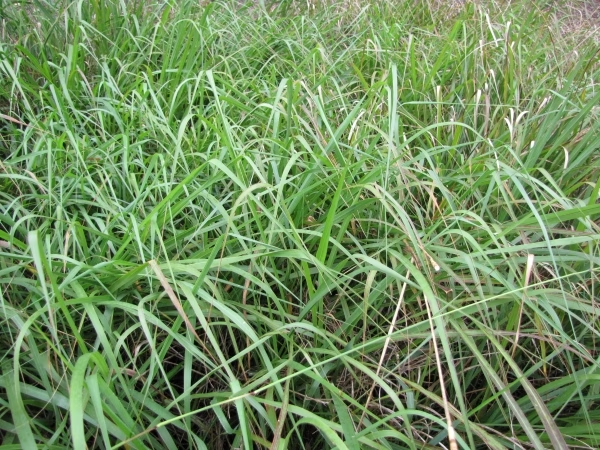
Eastern Gamagrass
Botanical Name
:
Tripsacum dactyloides
Plant Type
:
Warm-season perennial bunchgrass
Seasons
:
Active growth during late spring and summer but enters dormancy in fall and remains dormant through winter
Sun Level
:
At least 6–8 hours of direct sunlight daily
Ideal Soil Temperature for Planting
:
55–60°F (13–16°C)
Soil Type
:
Moist, fertile soils with good water-holding capacity. It can tolerate a range of soil types, including sandy loam, clay loam, and clay soils
Hardiness Zones
:
4–10 (USDA)
Germination
:
Can be established from seed using moist stratification for 1 ½ to 2 months. The tough outer seed coat delays germination, and scarification is recommended.
You can use growth stimulation hormones such as gibberellic acid to help to increase the rate of germination.
P.H. Level
:
5.5–7.5
Water/Irrigation
:
Requires consistent moisture during establishment, once established, it is drought-tolerant but performs best with adequate moisture
Fertilization
:
Generally does not require fertilization; however, if soil nutrients are poor, apply low to moderate nitrogen (1–2 lbs of nitrogen per 1,000 sq ft annually).
Properly fertilized, Eastern Gamagrass is suited for the reclamation of acid and compact soils and the production of high biomass of high-quality forage.
Habit
:
Extremely variable perennial clump grass, with short, fibrous, knotty rhizomes and deep, hollow roots. Culms form bunches
Propagation
:
Eastern gamagrass can be propagated through division and transplanting. Native grass seed should be sown, or plants transplanted in the fall.
Final Plant Height
:
Typically grows 6 to 9 feet tall
Spread
:
Spreads slowly via short rhizomes
Spacing
:
Space plants 4 to 6 feet apart to accommodate mature size
Flowers
:
Produces distinctive seed heads with bright yellow-orange stamens and red to brown or purple female flowers
Attracts
:
Provides habitat for wildlife, including cover for birds and small mammals
Uses
:
Suitable for forage, erosion control, ornamental landscaping, and wildlife habitat restoration
Companions
:
Often grown alone but can be mixed with other native grasses like switchgrass or big bluestem
Pruning
:
Remove dead vegetation in early spring before new growth begins, cutting back in spring promotes healthy growth
Toxicity
:
Non-toxic to humans and pets
Pests
:
Generally resistant to pests but can occasionally be affected by grasshoppers or aphids
Diseases
:
Resistant to most diseases but can occasionally suffer from frost heaving or leaf spot
Did You Know?
Eastern gamagrass has been used in phytoremediation efforts to clean up contaminated soils and wastewater due to its ability to sequester heavy metals like zinc
Botanical Name
:
Tripsacum dactyloides
Plant Type
:
Warm-season perennial bunchgrass
Seasons
:
Active growth during late spring and summer but enters dormancy in fall and remains dormant through winter
Sun Level
:
At least 6–8 hours of direct sunlight daily
Ideal Soil Temperature for Planting
:
55–60°F (13–16°C)
Soil Type
:
Moist, fertile soils with good water-holding capacity. It can tolerate a range of soil types, including sandy loam, clay loam, and clay soils
Hardiness Zones
:
4–10 (USDA)
Germination
:
Can be established from seed using moist stratification for 1 ½ to 2 months. The tough outer seed coat delays germination, and scarification is recommended.
You can use growth stimulation hormones such as gibberellic acid to help to increase the rate of germination.
P.H. Level
:
5.5–7.5
Water/Irrigation
:
Requires consistent moisture during establishment, once established, it is drought-tolerant but performs best with adequate moisture
Fertilization
:
Generally does not require fertilization; however, if soil nutrients are poor, apply low to moderate nitrogen (1–2 lbs of nitrogen per 1,000 sq ft annually).
Properly fertilized, Eastern Gamagrass is suited for the reclamation of acid and compact soils and the production of high biomass of high-quality forage.
Habit
:
Extremely variable perennial clump grass, with short, fibrous, knotty rhizomes and deep, hollow roots. Culms form bunches
Propagation
:
Eastern gamagrass can be propagated through division and transplanting. Native grass seed should be sown, or plants transplanted in the fall.
Final Plant Height
:
Typically grows 6 to 9 feet tall
Spread
:
Spreads slowly via short rhizomes
Spacing
:
Space plants 4 to 6 feet apart to accommodate mature size
Flowers
:
Produces distinctive seed heads with bright yellow-orange stamens and red to brown or purple female flowers
Attracts
:
Provides habitat for wildlife, including cover for birds and small mammals
Uses
:
Suitable for forage, erosion control, ornamental landscaping, and wildlife habitat restoration
Companions
:
Often grown alone but can be mixed with other native grasses like switchgrass or big bluestem
Pruning
:
Remove dead vegetation in early spring before new growth begins, cutting back in spring promotes healthy growth
Toxicity
:
Non-toxic to humans and pets
Pests
:
Generally resistant to pests but can occasionally be affected by grasshoppers or aphids
Diseases
:
Resistant to most diseases but can occasionally suffer from frost heaving or leaf spot
Did You Know?
Eastern gamagrass has been used in phytoremediation efforts to clean up contaminated soils and wastewater due to its ability to sequester heavy metals like zinc
Written by Salome Wapukha – https://www.linkedin.com/in/salome-wapukha-556700193/

